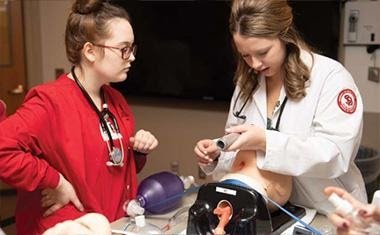Increasing Interprofessional and Simulation Learning Opportunities
The School of Health Sciences is ideally organized to provide interprofessional training, as the school contains a larger number of health programs and more health professions students than are found at any other university or college in the state.
‘We are preparing our students to be job-ready when they graduate.’
– Haifa Samra, Ph.D., Dean of the School of Health Sciences
Maximizing student learning and providing real-world preparation is the goal of interprofessional health care education and cutting-edge simulation centers contribute mightily to that objective. “We are preparing our students to be job-ready when they graduate,” said Haifa Samra, Ph.D., dean of the School of Health Sciences.
With that goal in mind, Samra and other School of Health Science officials recently announced the completion of an important expansion and remodel of the interprofessional simulation center located in the Lee Medical Building on the USD campus in Vermillion.
The expanded simulation facility allows for individual and team learning using human patient simulators – manikins – that can be manipulated to present patient-case situations, such as heart rates, blood pressure and other conditions. Actors simulating patients have been added to the facility’s learning scenarios. And two faculty members nationally certified in health education simulation guide learning activities.
The original simulation facility – opened in 2014 in Lee Med – consisted of three patient simulation rooms with adjacent observation/debriefing rooms featuring direct camera feed and video that are used by instructors and students to observe and analyze training exercises. The facility offers opportunities for students from the school’s numerous health care disciplines to work in teams to solve a patient’s health problems and determine diagnosis. The expansion adds two patient simulation rooms and two observation/debriefing rooms. Student training has increased from the original rate of 24 students per session to 40 students per session. This increase is significant, as students from the school’s 12 programs participate in simulation exercises.
Learning sessions in the simulation center blending students from different disciplines replicates real-world conditions, as modern hospitals and clinics are embracing the interprofessional approach to providing health care. It’s not unusual, for example, to see medical students and nursing students working together, or students from programs such as social work, dental hygiene and physical therapy in the same room working cooperatively while addressing patient needs.
USD has long been at the forefront of the national interprofessional education movement and has established an academic and research center (The Interprofessional Health Education Center, or IHEC) for enhancing interprofessional education within the School of Health Sciences, including faculty development. IHEC and the newly expanded simulation center work collaboratively and develop curricula designed to advance student competencies.
In addition to the newly expanded simulation center in Vermillion, health professions students also benefit from the Parry Center for Clinical Skills and Simulation, located in USD’s medical school campus in Sioux Falls. Alongside medical school students, health sciences students using the Parry Center benefit from the center’s staff of specially trained and certified simulation experts. No other health education institution in South Dakota offers its students the opportunity to learn in simulation settings with students from so many other health care disciplines, including medical students. This allows USD students optimal and realistic learning experiences like the type of circumstances and conditions they will face as they begin their health care careers.
“The goal of this level of training and education,” explained Dean Samra, “is to achieve better outcomes for patients, their families and their communities.”
Learn more about USD simulation www.youtube.com/watch?v=Ehb8drqEmXE
The Growth of Simulation at USD
In its first year of operation, the first simulation center in the Lee Medical Building offered 82 different learning sessions to 257 students. That number now exceeds 120 sessions serving more than 600 students each year. USD Nursing has utilized simulation-based learning for its students since 2003, and by 2010 this important tool had been fully integrated into the department’s curriculum. Since 2014 the center has seen more utilization for interprofessional education of USD School of Health Science students. Interprofessional education involves teaching students from various health care fields to work together, cooperatively and collaboratively.
USD has been a national leader regarding incorporating interprofessional preparation into its health professions education, including simulation exercises.
A simulation center contains rooms that simulate hospital/clinic rooms as well as observation and debriefing rooms to enrich student learning.
The Value of Simulation in Interprofessional Health Care
At the Lee Med simulation center, students improve patient assessment abilities and communication skills with patients and family members. They also learn the importance of interdisciplinary teamwork to deliver safe care and improve health outcomes.
A recent interprofessional exercise in the simulation center on the lower level of the Lee Medical Building had students from physical therapy, nursing and medical laboratory science working together to address and solve an emergency medical situation. A goal of this simulation and other interprofessional simulation exercises is to allow students to apply the knowledge and skills they learn within their own programs while learning about other disciplines. According to Adam Ladwig, DPT, assistant professor in the Department of Physical Therapy, these experiences “improve interdisciplinary communication, which better prepare students for the dynamic interaction required of effective health care teams in the real working world.”
This type of experience, Ladwig added, is the closest we can get to an actual patient experience while maintaining complete safety and supervision under the watchful eyes of faculty. “At times,” said Ladwig, “the students might be initially uncomfortable in these simulation experiences, but they finish with more confidence and understanding than when they started, and, hopefully, they are better prepared for a real medical emergency.”
Interprofessional education involves teaching students from various health care fields to work together, cooperatively and collaboratively, to benefit patients.













